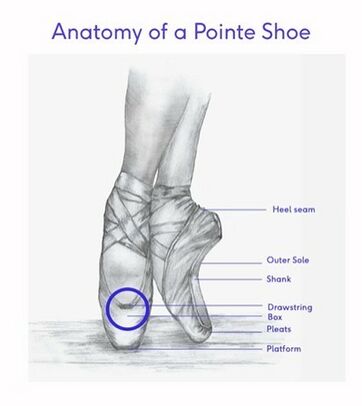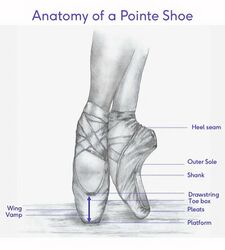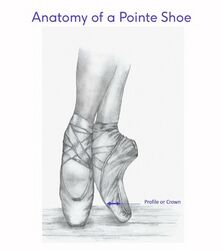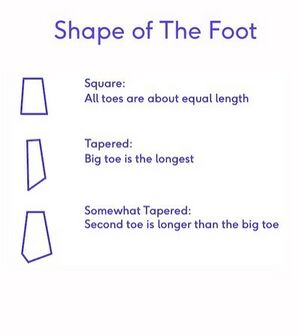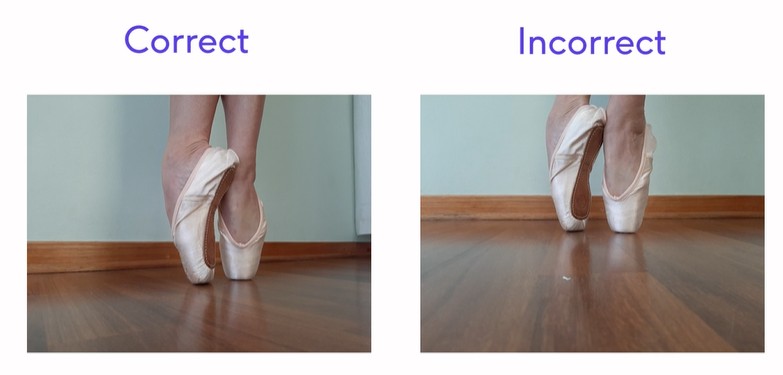Anatomy of the Pointe Shoe: Difference between revisions
Carin Hunter (talk | contribs) No edit summary |
Carin Hunter (talk | contribs) No edit summary |
||
| Line 49: | Line 49: | ||
== Breaking in Pointe Shoes == | == Breaking in Pointe Shoes == | ||
*This term is used when a ballet dancer: | *This term is used when a ballet dancer: | ||
**Breaks or cuts off the shank of the shoe. The purpose is to help | **Breaks or cuts off the shank of the shoe. The purpose is to help mold the shoe to the foot of the dancer for comfort. The shank strength will depend on your arch type and your arch flexibility. | ||
*Toe box must be broken in | *Toe box must be broken in | ||
| Line 70: | Line 70: | ||
== Effect of Toe Type on Postural Stability == | == Effect of Toe Type on Postural Stability == | ||
In | In a study conducted by Kizawa et al, they examined ballet dancers with Egyptian-type toes (or tapered toes) and with square type toes. There were no significant difference in postural stability between toe types when standing on both feet and in a demipointe position however dancers with square-type toes were more stable in pointe work than dancers with Egyptian-type toes.<ref name=":1">Kizawa M, Yasuda T, Shima H, Mori K, Tsujinaka S, Neo M. [https://www.researchgate.net/profile/Momoko-Kizawa/publication/330484163_Comparison_of_Plantar_Pressure_Distribution_Between_Postoperative_Hallux_Valgus_Feet_and_Healthy_Feet/links/5f46fec592851c6cfde2ace9/Comparison-of-Plantar-Pressure-Distribution-Between-Postoperative-Hallux-Valgus-Feet-and-Healthy-Feet.pdf Effect of toe type on static balance in ballet dancers.] Medical Problems of Performing Artists. 2020 Mar 1;35(1):35-41.</ref> | ||
In the dancers with square-type toes, the more similar toe length allows more simultaneous loading of the toe-tips and creating a larger surface area to support the body and load. This transmits balance ground reaction forces evenly through the two tips of the toes, resulting in smaller center of pressure displacement than that of Egyptian-type toes. | |||
In the dancers with square-type toes, the more similar toe length allows more simultaneous loading of the toe-tips and | |||
== Correct Shoe fit == | == Correct Shoe fit == | ||
* | *The shank strength will depend on your arch type and your arch flexibility | ||
* | *The heel height and width will have an influence on the heel section of the pointe shoe | ||
* | *The vamp length will depend on the ability of the toes to be compressed, the length of the toes and the flexibility of the arch. | ||
* | *The shoe profile height depends on the arch type and flexibility, the box shape and width, toe length and foot profile height | ||
* | * | ||
== Why do we want to get the right fit? == | == Why do we want to get the right fit? == | ||
The correct fit is essential for encouraging the correct load bearing points for the feet and subsequently for the rest of the body. Complications of overly compressed toes is a [[Morton's Neuroma|Mortons neuroma]], Bunions and [[Hallux Valgus]]. Toe type and postural stability <ref name=":1" />are essential when correctly fitting a pointe shoe. The pointe shoe is designed to assist the ballet steps whilst in plantarflexion, protecting the feet from impact forces and stabilising the performer <ref>Heather L. Walter, Carrie L. Docherty, and John Schrader. [https://www.ingentaconnect.com/content/jmrp/jdms/2011/00000015/00000002/art00002 Ground Reaction Forces in Ballet Dancers Landing in Flat Shoes versus Pointe Shoes.] Journal of Dance Medicine & Science, Volume 15, Number 2, 2011</ref> | |||
The pointe shoe is designed to assist the ballet steps | |||
'''<u>What to look out for in a pointe shoe as a physio:</u>''' | '''<u>What to look out for in a pointe shoe as a physio:</u>''' | ||
*Getting “Over the box” | *Getting “Over the box”: A good indication is wear and tear on the platform on both feet | ||
*Stiching around the platform can give proprioceptive feedback as to where they are on the toebox | *Stiching around the platform can give proprioceptive feedback as to where they are on the toebox | ||
*Needs to be central wear and not more to the left vs the right | *Needs to be central wear and not more to the left vs the right | ||
*Weak ankles | *Weak ankles need a rigid shank and must be weary of a flexible shank | ||
*Shank should curve in towards each other so there are no gaps between your feet in 5th position as shown below | *Shank should curve in towards each other so there are no gaps between your feet in 5th position as shown below | ||
[[File:Correct vs Incorrect Foot Gap.jpg|center]]Toes should be straight in the pointe shoe and not bent at all | [[File:Correct vs Incorrect Foot Gap.jpg|center]]Toes should be straight in the pointe shoe and not bent at all | ||
*“Ideal” foot structure for on pointe | *There is no “Ideal” foot structure for on pointe | ||
**Ankles less prone to injury | **Ankles less prone to injury | ||
***Toes of equal length | ***Toes of equal length | ||
| Line 116: | Line 101: | ||
***Uneven toe length | ***Uneven toe length | ||
***Inflexible / rigid ankle | ***Inflexible / rigid ankle | ||
***Low instep or flat arch. Flat arch requires dancer to work | ***Low instep or flat arch. Flat arch requires dancer to work on flexibility, although they usually present with good strength | ||
** | ** | ||
* | * | ||
==== Assessing the Shoe | ==== Assessing the Shoe ==== | ||
*Indications of an inexperienced dancer: | *Indications of an inexperienced dancer: | ||
** Shank not “broken in” | ** Shank not “broken in” | ||
**Elastic on the heel to keep shoe on. more experienced dancers will either have a proper shoe fit or sew elastic along the inside seam which results in less injuries, such as an irritated Achilles. | **Elastic on the heel to keep shoe on. more experienced dancers will either have a proper shoe fit or sew elastic along the inside seam which results in less injuries, such as an irritated Achilles. | ||
A pointe shoe will last approximately 20 hours of dancing according to a study conducted by Bickle et al.<ref name=":0">Bickle, C; Deighan, M and Theis, N. [https://www.sciencedirect.com/science/article/abs/pii/S0167945718301064 The effect of pointe shoe deterioration on foot and ankle kinematics and kinetics in professional ballet dancers.] Human Movement Science, 60. pp. 72-77. 2018 </ref>A worn pointe shoe has been shown to increase mid-foot flexion and ankle plantarflexion when en pointe. The impaired structural integrity of the used pointe shoe is thought to be a contributing factor to biomechanical changes which can lead to pain and injury. Professional ballet dancers are encouraged to change their pointe shoes multiple times during a show because of the demand on the shoes causing such a quick decrease to the structural integrity. <ref>Fong Yan A, Hiller C, Smith R, Vanwanseele B. [https://www.ingentaconnect.com/content/jmrp/jdms/2011/00000015/00000002/art00005 Effect of footwear on dancers: a systematic review.] Journal of Dance Medicine & Science. 2011 Jun 15;15(2):86-92.</ref><ref>Cunningham BW, DiStefano AF, Kirjanov NA, Levine SE, Schon LC. [https://journals.sagepub.com/doi/abs/10.1177/03635465980260041501 A comparative mechanical analysis of the pointe shoe toe box.] The American Journal of Sports Medicine. 1998 Jul;26(4):555-61.</ref> | |||
== Injuries related to pointe shoes == | == Injuries related to pointe shoes == | ||
Revision as of 20:36, 12 March 2022
Top Contributors - Carin Hunter, Jess Bell, Kim Jackson and Ewa Jaraczewska
Introduction[edit | edit source]
- Different styles and types of pointe shoes
- Freed
- Capezio
- Teplov
- Grishko
- Gaynor Mindens
Parts of the Pointe Shoe[edit | edit source]
- Drawstring
- Binding
- Toebox
- Sides or wings
- Pleats - plantar surface
- Platform
- inner sole
- outer sole
- Shank
- how many, how thick, how long
- goes according to the preference of your ballerina
- waist seams on left and right
- Back Seam
- Accessories
- Ribbons or elastics - used to secure shoe to foot
- Differences in the accessories can indicate injury (how you put them on basically will give you a good understanding of the preference of the ballerina, the years of experience on the ballerina and also potential injuries or current injuries that they have)
- Accessories
- Ribbons or elastics which are used to secure the shoe to the foot
- They way the accessories are attached can cause injuries on their own with stitching rubbing on tendons or bony prominences. The way the accessories are attached can also give an indication of the experience and preferences of the ballerina.
- Toe caps[1]
- Comfort, moldability, shock absorption, impact, sweat absorption, cushioning
- material or silicone
- Silicone - breathable, malleable, better compressibility, longer lasting
- Material - hardens with sweat from dancing
Important Measurements[edit | edit source]
The Vamp which is the length of the toebox.
The Crown, or Profile, which is the height of the toebox.
Breaking in Pointe Shoes[edit | edit source]
- This term is used when a ballet dancer:
- Breaks or cuts off the shank of the shoe. The purpose is to help mold the shoe to the foot of the dancer for comfort. The shank strength will depend on your arch type and your arch flexibility.
- Toe box must be broken in
- To do this they can be worn, danced in, have barre work done in them, compress the toe box with palm of hand or heel of foot or hit plantar surface of shoe on the floor
- The toe box of the pointe shoe must be strong enough to support the dancer en pointe but also be malleable enough to allow articulation of the joints of the foot and ankle.
- The natural foot arches need to be inline with where shank has been broken in. As a basic rule of thumb if a shoe has extensive bend, the ballerina often presents with a high arch. While if the shoe is stiff, the ballerina has a low arch. This is important to be remembered when assessing a ballet shoe. The dancer needs to be comfortable on flat, en pointe and in demi pointe.
- As a Physio, we can assist with breaking in shank by marking on their shoe where their natural arches are for the dancer to align the break in the shank with these.
Foot Shape[edit | edit source]
- Square
- Tapered
- Mortons foot type or somewhat tapered
Because of the variation in feet of dancers a ballet shoe needs to be professionally fitted. There are many different variations to a shoe. For example a shoe can have different shank length, shank height, shank width, vamp length, toe box length, wing height, the height of the platform, the height of the crown.
Effect of Toe Type on Postural Stability[edit | edit source]
In a study conducted by Kizawa et al, they examined ballet dancers with Egyptian-type toes (or tapered toes) and with square type toes. There were no significant difference in postural stability between toe types when standing on both feet and in a demipointe position however dancers with square-type toes were more stable in pointe work than dancers with Egyptian-type toes.[2]
In the dancers with square-type toes, the more similar toe length allows more simultaneous loading of the toe-tips and creating a larger surface area to support the body and load. This transmits balance ground reaction forces evenly through the two tips of the toes, resulting in smaller center of pressure displacement than that of Egyptian-type toes.
Correct Shoe fit[edit | edit source]
- The shank strength will depend on your arch type and your arch flexibility
- The heel height and width will have an influence on the heel section of the pointe shoe
- The vamp length will depend on the ability of the toes to be compressed, the length of the toes and the flexibility of the arch.
- The shoe profile height depends on the arch type and flexibility, the box shape and width, toe length and foot profile height
Why do we want to get the right fit?[edit | edit source]
The correct fit is essential for encouraging the correct load bearing points for the feet and subsequently for the rest of the body. Complications of overly compressed toes is a Mortons neuroma, Bunions and Hallux Valgus. Toe type and postural stability [2]are essential when correctly fitting a pointe shoe. The pointe shoe is designed to assist the ballet steps whilst in plantarflexion, protecting the feet from impact forces and stabilising the performer [3]
What to look out for in a pointe shoe as a physio:
- Getting “Over the box”: A good indication is wear and tear on the platform on both feet
- Stiching around the platform can give proprioceptive feedback as to where they are on the toebox
- Needs to be central wear and not more to the left vs the right
- Weak ankles need a rigid shank and must be weary of a flexible shank
- Shank should curve in towards each other so there are no gaps between your feet in 5th position as shown below
Toes should be straight in the pointe shoe and not bent at all
- There is no “Ideal” foot structure for on pointe
- Ankles less prone to injury
- Toes of equal length
- High instep
- Flexible ankle
- High arches, IF they are very strong
- Ankles more prone to injury
- Uneven toe length
- Inflexible / rigid ankle
- Low instep or flat arch. Flat arch requires dancer to work on flexibility, although they usually present with good strength
- Ankles less prone to injury
Assessing the Shoe[edit | edit source]
- Indications of an inexperienced dancer:
- Shank not “broken in”
- Elastic on the heel to keep shoe on. more experienced dancers will either have a proper shoe fit or sew elastic along the inside seam which results in less injuries, such as an irritated Achilles.
A pointe shoe will last approximately 20 hours of dancing according to a study conducted by Bickle et al.[4]A worn pointe shoe has been shown to increase mid-foot flexion and ankle plantarflexion when en pointe. The impaired structural integrity of the used pointe shoe is thought to be a contributing factor to biomechanical changes which can lead to pain and injury. Professional ballet dancers are encouraged to change their pointe shoes multiple times during a show because of the demand on the shoes causing such a quick decrease to the structural integrity. [5][6]
[edit | edit source]
- A worn pointe shoe with reduced structural integrity may reduce the ability of a dancer to correct postural sway, resulting in accelerated rates of muscle fatigue, ankle sprains or falls[7]
- during pointe work a dancer is required to maintain full plantarflexion of the ankle, extending through the mid-foot to the toes. This is achieved predominantly by movement of the talocrural joint and to lesser extent by bones of the foot[8] . A worn pointe shoe, which has increased flexibility, may no longer be able to support the foot and ankle in the required position, and as a result, hyperplantarflexion of the talocrural joint and excessive mid-foot flexion may occur[9].
- The condition and integrity of the ballet shoes is a contributing factor to injuries in a ballet dancer. The most common injuries relating to worn ballet shoes are overuse and acute injuries.[9]
- Considering joints and ligaments of the foot are not designed to accept excessive loading, these changes could lead to the compression of soft tissue structures[10] and strains in the midfoot ligaments[11]
- a lack of sufficient shock absorbing material
- A new pointe shoe may contribute to the attenuation of ground reaction forces [4]
- Take home points
- Send a dancer to a professional fitter
- “Too much, too soon” - applies to moving on to pointe work. Body should be ready to accept the load with correct shoe fit, adequate ROM and strength through the range[12]
- Need to be able to articulate through range from flat, to demi pointe, onto point, as well as reversing the movement
References[edit | edit source]
- ↑ Annamaria Salzano, Fabiana Camuso, Mario Sepe, Maha Sellami, Luca P. Ardigò, and Johnny Padulo, Acute Effect of Toe Cap Choice on Toe Deviation Angle and Perceived Pain in Female Professional Ballet Dancers. BioMed Research International Volume 2019, Article ID 9515079, 8 pages https://doi.org/10.1155/2019/9515079
- ↑ 2.0 2.1 Kizawa M, Yasuda T, Shima H, Mori K, Tsujinaka S, Neo M. Effect of toe type on static balance in ballet dancers. Medical Problems of Performing Artists. 2020 Mar 1;35(1):35-41.
- ↑ Heather L. Walter, Carrie L. Docherty, and John Schrader. Ground Reaction Forces in Ballet Dancers Landing in Flat Shoes versus Pointe Shoes. Journal of Dance Medicine & Science, Volume 15, Number 2, 2011
- ↑ 4.0 4.1 Bickle, C; Deighan, M and Theis, N. The effect of pointe shoe deterioration on foot and ankle kinematics and kinetics in professional ballet dancers. Human Movement Science, 60. pp. 72-77. 2018
- ↑ Fong Yan A, Hiller C, Smith R, Vanwanseele B. Effect of footwear on dancers: a systematic review. Journal of Dance Medicine & Science. 2011 Jun 15;15(2):86-92.
- ↑ Cunningham BW, DiStefano AF, Kirjanov NA, Levine SE, Schon LC. A comparative mechanical analysis of the pointe shoe toe box. The American Journal of Sports Medicine. 1998 Jul;26(4):555-61.
- ↑ Beynnon BD, Murphy DF, Alosa DM. Predictive factors for lateral ankle sprains: a literature review. Journal of athletic training. 2002 Oct;37(4):376.
- ↑ Jeffrey A. Russell, Ruth M. Shave, David W. Kruse, Alan M. Nevill, Yiannis Koutedakis and Matthew A. Wyon. Is Goniometry Suitable for Measuring Ankle Range of Motion in Female Ballet Dancers? An Initial Comparison With Radiographic Measurement. Foot Ankle Spec 2011 4: 151 originally published online 2 March 2011
- ↑ 9.0 9.1 Aquino J, Amasay T. Biomechanical comparison of “dead” and “new” pointe shoes in female professional ballet dancers. The Sport Journal. 2019;21.
- ↑ Moser BR. Posterior ankle impingement in the dancer. Current Sports Medicine Reports. 2011 Nov 1;10(6):371-7.
- ↑ Russell JA, Kruse DW, Nevill AM, Koutedakis Y, Wyon MA. Measurement of the extreme ankle range of motion required by female ballet dancers. Foot & ankle specialist. 2010 Dec;3(6):324-30.
- ↑ Kimberly P Veirs, Jonathan D Baldwin, Josiah Rippetoe; Andrew Fagg ; Amgad Haleem ; Lynn Jeffries; Ken Randall; Susan Sisson; Carol P Dionne, Multi-Segment Assessment of Ankle and Foot Kinematics during Relevé Barefoot and En Pointe. Orthopaedic Practice volume 32 / number 3 / 2020
